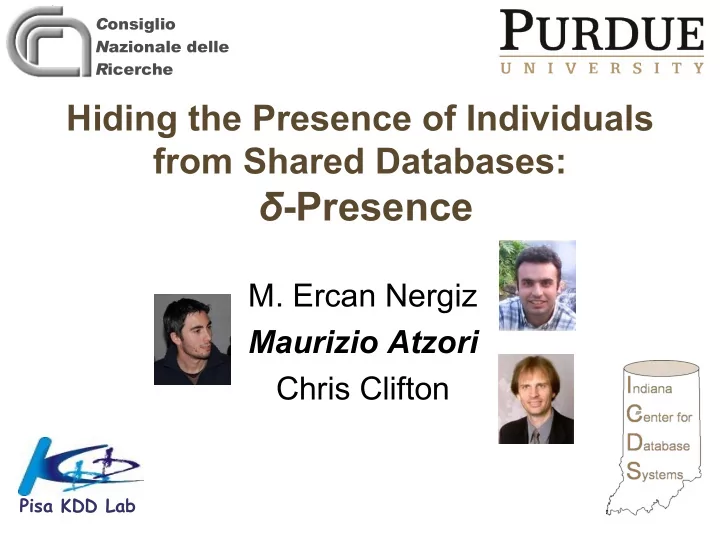

C onsiglio N azionale delle R icerche Hiding the Presence of Individuals from Shared Databases: δ -Presence M. Ercan Nergiz Maurizio Atzori Chris Clifton Pisa KDD Lab
Outline • Adversary Models – Existential Uncertainty Model • δ -Presence – Checking for δ -Presence Property – Providing δ -Presence • Future Work 2
Adversary Models Original Dataset Age Sex Address Disease Adversary: 17 M W. Lafayette Obesity “I know that Chris is ‘Male’, from ‘W. Lafayette’ and 16 M Lafayette Obesity 17-year-old. 23 F Lafayette Tetanus What is his disease?” 25 F Indianapolis Flu k-Anonymity Age Sex Address Disease 15-18 M G. Lafayette Obesity “Chris is definitely obese.” 15-18 M G. Lafayette Obesity 22-26 F Indiana Tetanus 22-26 F Indiana Flu 3
Adversary Models l-Diversity, t-Closeness Age Sex Address Disease 15-26 * Indiana Obesity Adversary: “Chris is not necessarily 15-26 * Lafayette Obesity obese.” 15-26 * Lafayette Tetanus 15-26 * Indiana Flu Anatomization Age Sex Address Disease 17 M W. Lafayette {Ob,Flu} Adversary: “Chris is still not necessarily 16 M Lafayette {Ob,Te} obese.” 23 F Lafayette {Ob,Te} 25 F Indianapolis {Ob,Flu} 4
Adversary Models and Possible Threats • Existential Certainty: Adversary knows that the individual is in the private dataset and tries to learn the sensitive information about the individual in the private dataset. – Linking Attacks: Linking Identities with sensitive attributes • Existential Uncertainty: Adversary doesn’t know the individual is or is not in the private dataset. – Linking Attacks: Existential disclosure is not considered as a privacy violation given that sensitive information is protected according to given privacy constraints. – Presence Hiding: Disclosure of existence or absence of an individual in the private dataset is a privacy violation. 5
k-Anonymity • Provides some protections for all of the adversary models. – Sensitive info protection – Identity protection by QI anonymizations • BUT is not perfect for any of the models 6
k -Anonymity Extensions k -Anonymity Existential Existential Certainty Uncertainty Linking Attacks Linking Presence Attacks Hiding l -Diversity t -Closeness Anatomization Weak k -Anon. δ -Presence 7
δ -Presence • The risk is simply from identifying that an individual is (or is not) in an anonymized dataset. • Can be interpreted in terms of increased risk of disclosure. • A meaningful bridge between human- understandable policy and mathematically sound standards for anonymity. – E.g., can we speak of privacy in terms of risk/cost/benefit? – Can convert $ to δ (see paper). 8
δ -Presence Given an external (public) background knowledge P , and a private table T; δ = ( δ min , δ max )-presence holds for a generalization T* of T if δ min ≤ Pr(t Є T | T*,P) ≤ δ max for every t Є P 9
Presence Challenge P T How to find δ- present generalization of T? 10
Checking for Presence Property: Non-overlapping Generalization • A generalization T* of T is a non- overlapping generalization w.r.t. P if – every tuple in P can be mapped onto at most one equivalence class in T* . • Checking presence property for non- overlapping generalizations is easy 11
Checking for Presence Property: Non-overlapping Generalization Ex. P T* 12
Checking for Presence Property: Non-overlapping Generalization Ex. P* T* * 13
Checking for Presence Property • Let T* be a non-overlapping generalization of T w.r.t. P . Then T* is δ -present, if for each equivalence class ec of the corresponding P* : δ min ≤ (# of 1s in Sen.) / | ec | ≤ δ max 14
(.5-.66)-Presence P* T* Pr(t a Є T | T*) = 0.5 Pr(t g Є T | T*) = 0.66 15
k -Anonymity Fails P* 5-anonymous T* Pr(t a Є T | T*) = 0 Pr(t b Є T | T*) = 1 16
How to Provide Presence?: Anti-monotonicity • Given a public table P , private table T , a non-overlapping generalization T 1 * of T , and a non-overlapping generalization T 2 * of T 1 * . If T 2 * is not δ -present w.r.t. P and T then neither is T 1 * . 17
How to Provide Presence?: SPALM, MPALM • SPALM: Optimum Single Dim. Presence Alg. – Analogous to Incognito [LDR SIGMOD05] – Top down pruning approach • MPALM: Multi Dim. Presence Alg. – Analogous to Mondrian [LDR ICDE06] – With different attribute selection heuristics 18
Experiments 19
Experiments 20
Future Work • Assume distribution of attributes instead of a public table. • Apply randomization on private table T to satisfy presence. • Design a clustering based presence algorithm with overlapping equivalence classes. • Assume sensitive attributes exist in T • Make risk analysis on the selection of δ parameters w.r.t. real world scenarios. • Personalize privacy based on attributes of the individuals. 21
Hiding the Presence of Individuals from Shared Databases: δ-Presence Thanks for listening atzori@di.unipi.it Questions? 22
Recommend
More recommend